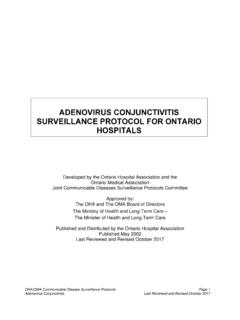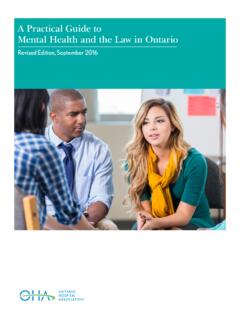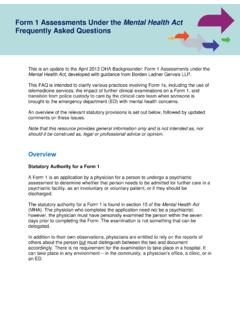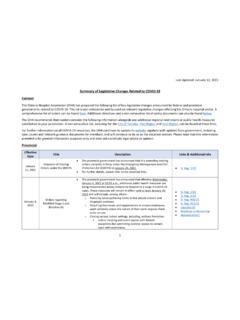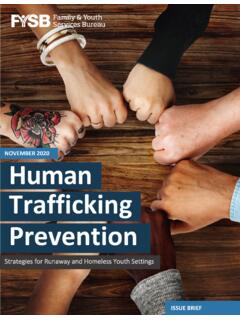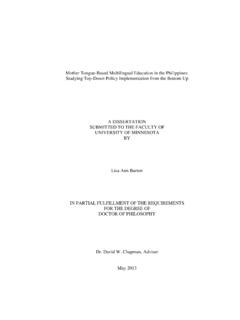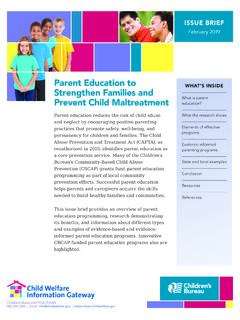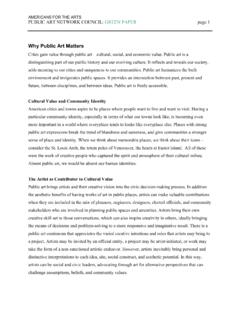Transcription of Effective Communication Strategies for COVID-19
1 Effective Communication Strategies for COVID-19 RESEARCH BRIEF1 Effective Communication is in its own right a non-pharmaceutical intervention (NPI) for COVID-19 that can increase adherence to protective behaviours necessary to mitigate the spread of the virus. There is no best practice for Communication during a complex public health emergency, but past experience has led to several principles that contribute to a successful we work to support hospitals and reduce the spread of COVID-19 , the Ontario Hospital Association (OHA) focused on understanding the impact of the complexities of behaviour and cognitive biases that can lead to more Effective Communication Strategies with the goal of encouraging behaviours that reduce the spread of COVID-19 .
2 To further support hospitals and their communities, the OHA has prepared a summary of the research and resources for Effective Communication Strategies for COVID-19 and guidance on how to evolve Strategies over the course of the pandemic to ensure impact and reach. Elements and Principles of Effective Communication StrategiesThere are a number of published guides from the World Health Organization (WHO), the US Centers for Disease Prevention and Control (CDC), and others that outline good risk Communication based on lessons learned from past health crises, including Ebola and Zika (Toppenberg-Pejcic et al.)
3 , 2019).Early learnings are also being drawn from jurisdictions that have thus far been successful at containing transmission of the virus and preventing deaths. Researchers at University of British Columbia have identified five main principles of democratic health communications that have enabled some countries to successfully control widespread transmission of COVID-19 (Tworek et al., 2020). Choosing appropriate language and metaphors is also an important component of Effective British Columbia Centre for Disease Control (BCCDC) has released a COVID-19 language guide that outlines preferred phases and words to use in order to avoid stigma, implying fault, and putting undue onus on metaphors may do more harm than good.
4 War metaphors ( , fight, battle, attack), particularly entrenched in health and disease rhetoric, may lead to stigmatization and xenophobic action rather than societal cohesion (Nie et al., 2016; Bates, 2020; Serhan, 2020).The table below synthesizes and combines evidence-based recommendations for Effective messaging and Communication from across various documents in the Resources referenced at the end of this document. 2 ELEMENTS/PRINCIPLESMEASURESEXAMPLEST rust and CredibilityDo Acknowledge uncertainty; explain what is known/unknown Be honest and transparent.
5 Explain what actions are being taken and why Employ mechanisms of accountability Rely on messengers who are competent and experts in the field Be consistent in messaging Use simple messages Correct misinformationAvoid Over reassurance Fostering unrealistic expectations Drawing too much attention to misinformationAngela Merkel, chancellor of Germany, used science and clear explanations of disease modelling in discussing an exit out of lockdown. Christian Dorsten, a leading coronavirus virologist in Germany and advisor to Angela Merkel, launched a podcast in February to explain the science behind the virus and latest Director General of the Norwegian Institute of Public Health admitted that the lockdown was likely excessive and that the same outcome could have been achieved with less restrictive , a brand selling frozen sliced meat, became an unlikely source for good science Communication , education in media literacy and critical thinking.
6 And dispelling misinformation. EmpathyDo Acknowledge concerns, hardship and express understanding Express gratitudeAvoid Shaming and blaming people and organizations Nicola Sturgeon, Scotland s First Minister, delivered a speech to Parliament on September 22 that is empathetic and expresses gratitude to the people of Scotland for their ongoing and EmpowermentDo Give people choice within a set of guidelines/principles Express confidence in people s ability Give people things to do Provide specific descriptions of desired behavioursAvoid Being paternalistic and overly authoritarian Implying that the facts are too difficult to understandBC laid out a set of principles for safe socializing rather than issuing specific
7 Restrictions on smaller , Emotions, and StoriesDo Focus on messages of solidarity, kindness, and love Appeal to collective good Link behaviours to people s identities Focus on people adopting desirable behaviour Outline/stories that contextualize risk Respect cultural beliefs/valuesAvoid Drawing attention to undesirable behaviours Appealing to fear Militaristic analogies/metaphors that may breed fear and xenophobic sentimentBoth Germany and South Korea adopted messaging that focused on solidarity and encouragement of public , ranked second in a Financial Post COVID-19 Global Response Index.
8 Has acknowledged each death and extended condolences to InvolvementDo Engage public in raising awareness Use messengers trusted by target audience Amplify public voicesIn New Zealand, Jacinda Ardern has live streamed her conversations with regular New Zealanders to share their stories and advice in Conversations through COVID. SpeedDo Communicate accurate information as early as possible Acknowledge that early information may changeAvoid Allowing misinformation and rumour to fill information void Taiwan launched an early communications strategy coordinated by the Central Epidemic Command Center that reduced panic buying and increased respiratory hygiene practices.
9 Audience SegmentationDo Make messages sensitive to demographics of intended targetThe BC CDC released a campaign targeted at youth called Dr. Bonnie Henry s Good Times Depoliticize health Communication Create a pandemic Communication unit Limit the number of institutions/people delivering messagesSouth Korea has given all Communication control to the Korean Centres for Disease Control and Prevention (KCDC) and its Office of mostly deferred public health messaging to Dr. Bonnie Henry, the provincial health officer.
10 4 Challenges to Effective Communications Many social and behavioural factors moderate the impact of Communication during crises. Information processing is affected by stress and uncertainty. People may not hear, not remember, or misinterpret information. People hold on to tightly held beliefs and may be less likely to engage in behaviour that is counterintuitive. People may exhibit confirmation bias and seek out information that supports their beliefs. The first message tends to be believed the most strongly. Subsequent information is compared to this first message.
